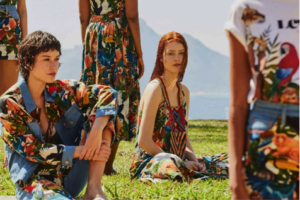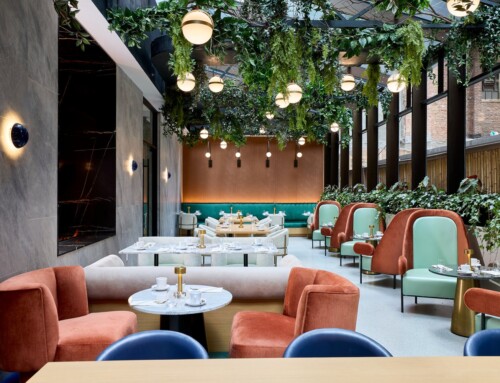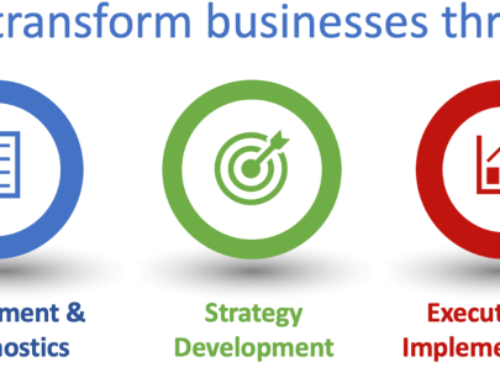TGC recently sat down with Daniel Martinez, Farm Rio’s Global Retail Director to discuss his new role, the current state of the business and the US retail strategy that TGC developed with the Farm Rio team.
 Farm Rio, a vertically integrated Brazilian apparel company that designs, produces, and markets colorful print garments inspired by its local cultural and environmental roots, was founded in 1997 by Marcello Bastos and Katia Barros. In 2010, it became part of the newly created Grupo Soma, a multi-brand company which has grown to be one of the largest apparel groups in Brazil.
Farm Rio, a vertically integrated Brazilian apparel company that designs, produces, and markets colorful print garments inspired by its local cultural and environmental roots, was founded in 1997 by Marcello Bastos and Katia Barros. In 2010, it became part of the newly created Grupo Soma, a multi-brand company which has grown to be one of the largest apparel groups in Brazil.
The brand began planning for its US debut in 2018 and a year later opened a store in the SoHo section of New York and then one north of Miami in Aventura Mall, along with a few experimental pop-up stores in select markets. Within a year of opening stores, COVID hit. Against all odds, Farm Rio’s US sales grew within 3 years from zero to $50 million, fueled by a strong and differentiated product and brand aesthetic and a multi-pronged distribution strategy that encompasses stores, e-commerce, and most critically, a robust wholesale network that includes Neiman Marcus and Nordstrom, among others. 
In the next five years, Farm Rio plans to open between 25 and 40 new stores in the US, in addition to SOHO, Aventura, and a recently added store in the Venice section of Los Angeles. Fabio Barreto, CEO of Farm Rio Global, engaged The Grayson Company (TGC) to assist in defining and navigating Farm Rio’s expansion plan for the United States.
TGC recently sat down with Daniel Martinez, Farm Rio’s Global Retail Director to discuss his new role, the current state of the business and the US retail strategy that TGC developed with the Farm Rio team.
TGC: Our work with you included two phases: first, devising a store operating model to maximize productivity and profitability; and second, developing a store expansion/location strategy including identifying descriptive customer geodemographics, clusters of likely customers and shopping centers/districts that serve them, and an estimate for US store location growth potential. What were the most important learnings that came from the project?
Daniel: We learned a great deal, but our key learnings can be classified into four buckets-
First, understanding the customer by using sales and customer data to clearly define our US customer. The entire team, including the CEO, was very impressed with TGC’s methodology using sales information available via wholesale, retail, and e-commerce channels to paint a picture of who the client is by deploying geodemographic segmentation as well as AI analysis of cell phone tracking data, and then finding population clusters of look-alike customers across the entire US.
Second, site selection strategy. The customer analytics made site identification very easy for us and also makes it easy to understand how to prioritize new stores based on where we find more households and a bigger penetration. This methodology gave us a very data-driven approach to selecting the MSAs that are best for the brand. The detailed maps TGC provided within the MSAs that identified the concentrations of our customers, the centers and shopping districts at which they shop, and competitor locations give us detailed information on how to proceed and prioritize our expansion.
Third, store growth potential for the US and the need to populate a pipeline. We had no idea at first about how many stores we could have in the United States. TGC’s deliverable gave us an idea of how many total stores were possible. Post-COVID with everyone switching back to physical retail locations we need to be competitive. Using the customer, site selection, and store growth information and analytic methodology we could present a strong case for growth to our investors. The list of stores is broad but very specific with enough locations identified that I can be patient and confident in my decisions. I don’t need to accept a bad deal in Brooklyn because I have so many other potential locations in LA and San Francisco. Austin is a great example of a market in the pipeline for which we are exercising patience. The data shows that we could have a store there and we would love to, but at the moment it is hard to find a space.
Fourth, the need for a US-centric retail organizational structure, skill sets, and operating model that empowers the US team to think and act outside the box. Neither Aventura or SOHO had 12 months of operational history before COVID hit the US. Some of the learnings TGC shared were eye-openers for us. We were operating the way we were accustomed to in Brazil, but you made it clear that we needed a US-centric structure with US-based leadership. One of the key take-aways for the stores was TGC’s “Echo-Amplify” framework for best sellers. Before, our visuals focused purely on what looked good. After the insights, we now consider what is selling as well as what looks good together. You were able to convince the visual team of the effectiveness of this approach as well. We have hired a new manager at our Venice store with very strong experience in the US and we have empowered her to think outside the box using this new US-focused approach and the new recommended merchandising, working culture along with Clientelling. That store is now our top performer, with the highest sales per square foot, conversion, and average transaction value.
I inherited the TGC project when it was nearing completion. My only regret is that I was not part of the project from the beginning. But in the end, it didn’t matter because the project was such a success.
We knew there were no simple solutions or silver bullets, and Farm Rio even changed the scope multiple times during the project. TGC was very flexible and not only delivered great recommendations, but the recommendations were very actionable. We are highly pleased with the results.
 TGC is a consulting group that offers a full range of consulting services to retail, ecommerce, wholesale, and omni-channel businesses, as well as investment firms focused on the consumer sector. Our team brings “best of breed” resources to bear on every functional area of the business.
TGC is a consulting group that offers a full range of consulting services to retail, ecommerce, wholesale, and omni-channel businesses, as well as investment firms focused on the consumer sector. Our team brings “best of breed” resources to bear on every functional area of the business.




